Aboriginal and Torres Strait Islander viewers should use caution viewing this post, as it may contain mentions of deceased persons.
Spinifex and sand. Jolting along an invisible desert track in the middle of the Australian desert, guided by two Aboriginal elders, we’re surrounded by nothing but red sand and waist-high spinifex grass. But somewhere in this desert there is water.
We’re in the heart of Martu country, where Nature Conservancy scientists are using remote data loggers to understand the impacts of feral camels on desert waterholes. The large GPS screen bolted to the Land Cruiser dash, though accurate, is utterly useless as neither our track nor our destination are on a map.
But elder Thelma Judson knows the way. Pointing silently, she redirects Eddie back onto the track only she can see. “Not far,” she says.
Walking On Country
The sand was already radiating heat as we walked through Parnngurr community the previous morning. Before we can start our fieldwork, we need to figure out which desert rockholes are the best ones to monitor for camel activity. And the best way to figure that out is to ask the Martu.
The traditional owners of this stretch of the Western Desert, the Martu people were some of the last Indigenous Australians to encounter Europeans — some as late as the 1960s — and subsequently be forced off of their land. In the early 1980s the Martu began slowly returning to country, and in 2002 they were awarded Native Title rights to their land by the Australian government. For younger Martu, it was the first time visiting their country. For the Martu elders, it was the first time they had seen their country in two or more decades.
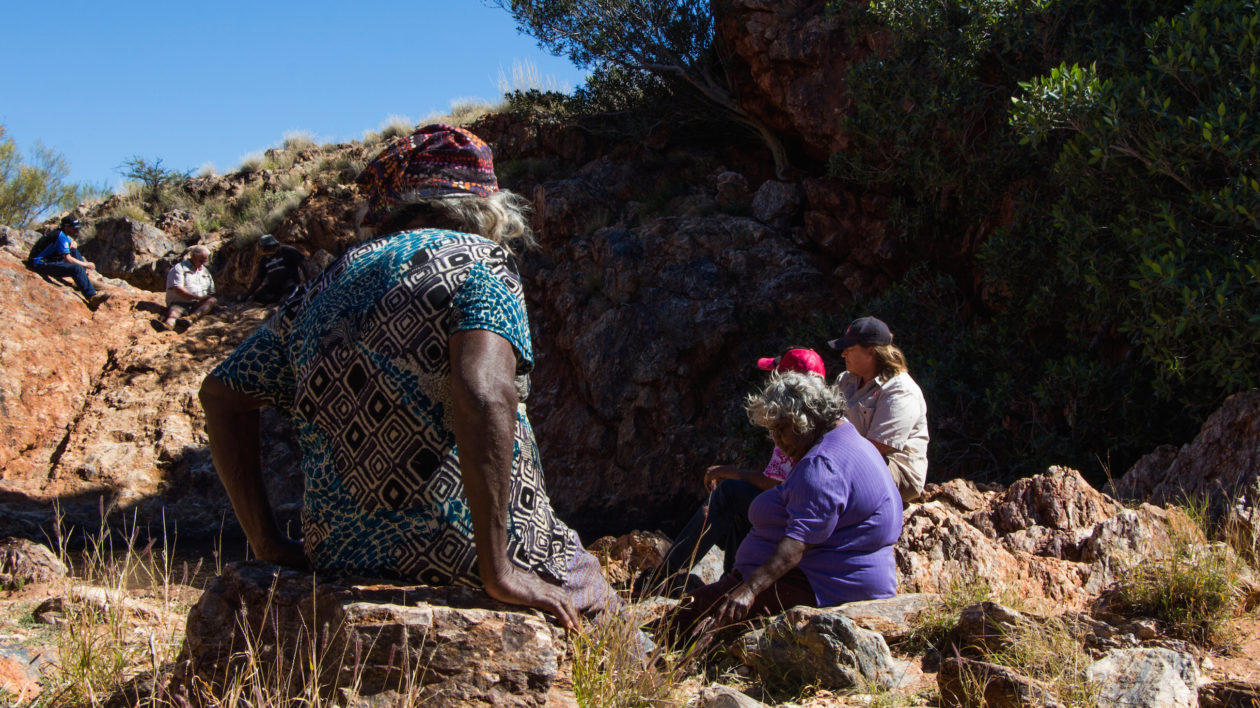
First we visit Waka and Muuki Taylor, two of the most senior members of the community. More than 25 dogs roam the yard, most lounging in small patches of shade beneath gum trees and plastic chairs.
Tina and Ray de Groot — ranger coordinators for the Martu cultural organization Kanyirninpa Jukurrpa (KJ) — kneel down in the sand and spread a map across a rusting bedframe. Hundreds of small black dots are scattered across the desert, each labeled with a numerical code and both English and Martu names. Nodding slowly, Waka suggests waterholes to the north, in Karlamilyi, and to the east.
Thanking him, we walk back through the chain-link gate and down the road to another house. Another Martu elder, Ngamaru Bidu, is sitting in the shade outside, a multicolor head sock covering her graying hair. Tina de Groot asks Ngamaru to recommend more waterholes, especially ones frequented by camels. She gazes at the map, pointing a sun-weathered hand to two waterholes, Jiwal Jiwal and Jurrar, in the lands east of Parnngurr. Her country.
“That’s where you walked when you were a girl, didn’t you?” asks de Groot. “Yes, I’ve been walking,” Ngamaru replies. “I’ve been walking everywhere.”
I’ve been walking. I’ve been walking everywhere.
Ngamaru Bidu
Islands in a Sea of Sand
Waterholes are scattered through Australia’s Western Desert like islands in a sea of sand. Some are mere damp soaks in the earth, some are small, rock-bound collections of rainwater no bigger than a bathtub, and still others are large, deep pools shaded from the relentless sun by groves of gum trees.
These water bodies hold immense cultural importance for the Martu people. Martu elders’ knowledge of waterholes was crucial in their fight to regain rights to their land, and a major thrust of KJ’s cultural work is creating a comprehensive, accurate map of all waterholes on country.
Waterholes are critical for the desert’s wildlife, too. Despite being well adapted to life in an arid environment, many desert fauna still depend upon small amounts of liquid water. “So changes to the availability of water in the desert will have a whole host of flow-on consequences for the flora and fauna that use them,” says Eddie Game, the Conservancy’s lead scientist for Asia Pacific.
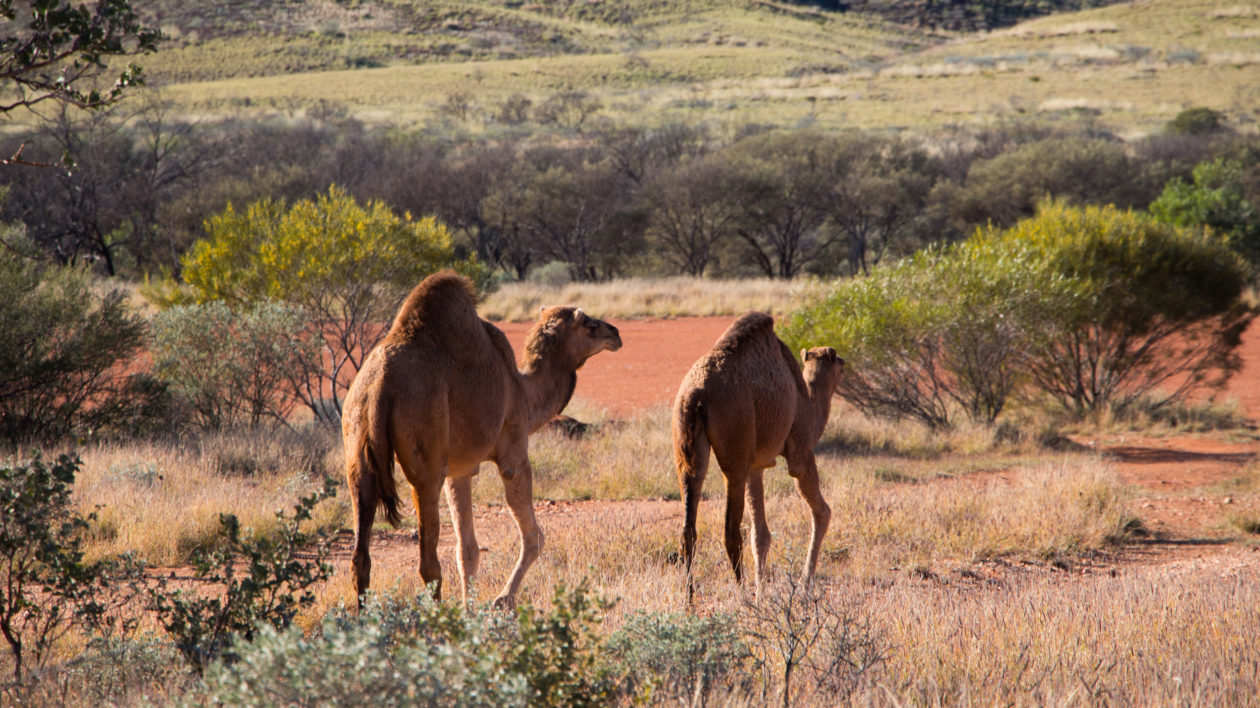
Camels in the Desert
Distances do not come easily in this desert, and an hour later we’re still driving. We plow south-east through the spinifex, Game at the wheel and Thelma guiding the way along the length of the Seven Sisters escarpment, glowing red in the sunlight. Suddenly, a shape materializes amid the waving grass: a camel, strolling slowly along about 50 meters from the track. And then two more appear.
We stop, they stop, and we all stare at each other for a few seconds before the camels walk on.
These dromedaries are just three of more than 300,000 feral camels in arid Australia — the largest population of feral camels in the world. Imported in the late 1800s to help immigrants access Australia’s arid interior, camels are now a major presence on the landscape and a threat to the desert ecosystem. Research in other areas of Australia indicates that camels can damage waterholes — consuming large amounts of water, trampling and destroying vegetation, eroding banks, and fouling the water with feces.
“But we don’t exactly know how camels impact waterholes on Martu country, or if the Martu’s camel management benefits the waterholes,” says Chris O’Bryan, a PhD candidate at the University of Queensland and volunteer with the Conservancy.
Through a collaboration with KJ, the local Martu cultural organization, and the resources company BHP Billiton, The Nature Conservancy is helping the Martu manage their country by blending science and land management practices with traditional knowledge and culture. Game and O’Bryan are using long-term data loggers to help assess if KJ’s annual camel culls are having a positive effect on waterhole health.







Into the Waterhole
Ten minutes later Thelma and Ngamaru instruct us to stop. To me, this patch of desert looks identical to the rest, except for a cloud of zebra finches that erupts from a nearby shrub, circles, and then alights on another. Following the women, we walk across the bare rock until we come to the waterhole — a basin in the bedrock so well hidden that you nearly stumble in before you see it.
“Wanti,” Ngamaru calls, beckoning me over with the Martu word for ‘woman.’ Pointing to a strip of sand near the pool’s rim, she shows me a clear, fresh emu track and a few bits of white down floating in the breeze. “This is a low one for emu,” she says, “it’s easy for them.”
We three sit on the stone as Game and O’Bryan set to work. Game lowers himself into the cool, chest-deep water, scattering a handful of massive, bloated tadpoles. O’Bryan hands him the data logger — firmly secured with PVC-piping and a cinderblock to hold it steady in the water — and Game positions it carefully on the bottom of the rockhole.
This data logger will measure the dissolved oxygen levels (DO) in this waterhole for the next 6 months. “It’s sort of a general indicator of health,” says Game, “maybe a bit like taking our temperature.”
Life in a waterhole — from bacteria to plants to amphibians — needs oxygen. But using oxygen as an indicator of health requires a lot of data. DO fluctuates on a diurnal cycle, increasing throughout the day as plants photosynthesize and then decreasing through the night as they respire.
“DO changes a lot in a single day, so you need long-term loggers to really get meaningful data,” explains Game. “If you turn up at different times then that measurement on its own is kind of meaningless.” And many of these waterholes are a multi-day off-road drive from the community, making frequent measurements impractical.
Where you have camels you have camel feces, and where you have camel feces you have bacteria. When camels defecate in waterholes, breeding bacteria tends to rapidly drop DO levels and make the waterhole less healthy. “We would expect waterholes that have severe camel impacts to have less oxygen,” says Game. “But it’s a bit unknown how severe that drop in DO is or how long it lasts.”
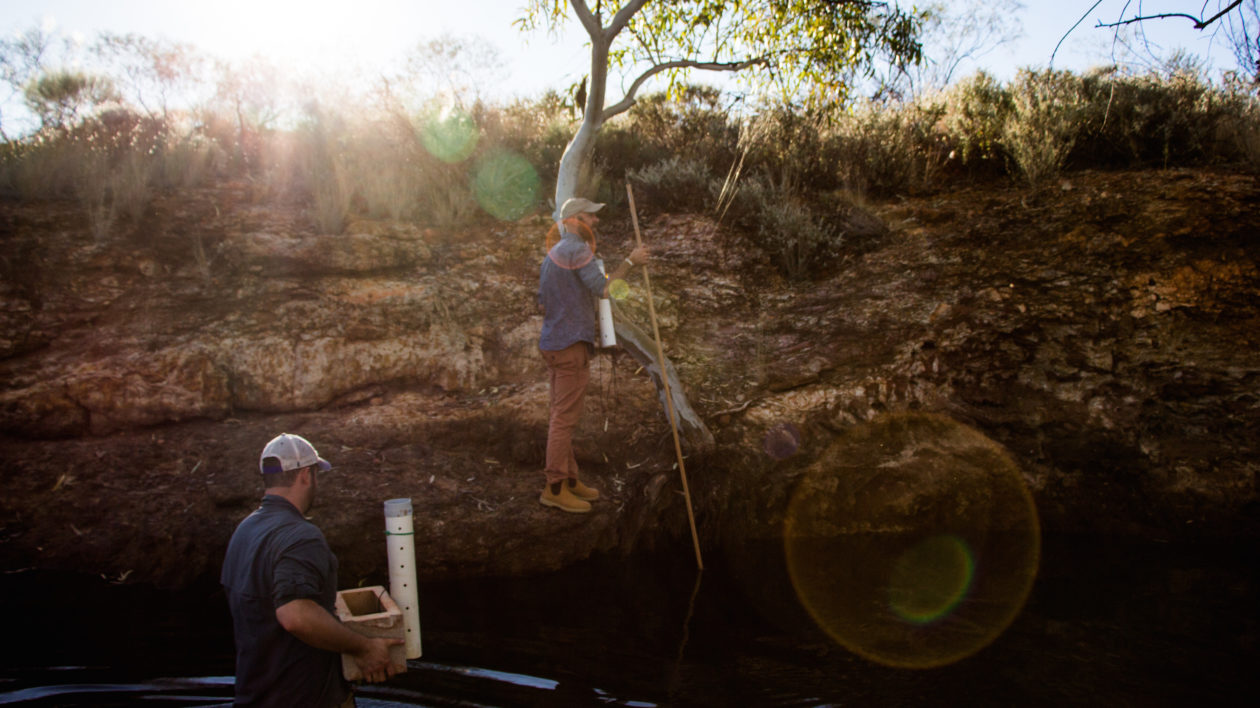
But camels can create a second major problem for waterholes, besides defecation-induced deoxygenation. They can literally drink them dry.
“Camels may not drink that often,” explains O’Bryan, “but when they do drink they drink a lot, as much as 200 liters at a time.” Game and O’Bryan are installing a second type of data logger that uses barometric pressure to measure changes in water depth to a fraction of a millimeter. They’ll sync that data up against images from camera traps installed nearby to see how dissolved oxygen and water levels change (and by how much) after camels cruise in for a visit.
“We’ll get a sense of the extent of camel water use and how much less water is available on country as a result of camels,” says Game.
Previously, Game and the Parnngurr rangers deployed five data-loggers in the McKay Range in June 2015 to test how well the equipment performed in the harsh desert conditions. Ranger teams will check this new set of loggers every 6 months, refreshing batteries and downloading data. If Game, O’Bryan, and the rangers are successfully able to tie changes in dissolved oxygen and water levels to camel presence, they’ll then expand the monitoring to cover waterholes across the country to areas with and without active camel management.
“The first step of this project is understanding the real-time impacts of camels on waterholes,” says Game, “and then the second step will be gauging the effectiveness of camel management.”
As a bonus, these data can also be used to study how desert hydrology is changing over time with climate change. “The Martu have traditional ecological knowledge about how long water stays in these holes, but rainfall patterns are changing,” says Game, “so we don’t really have a sense of how much water there is and how long that water stays on the landscape.”
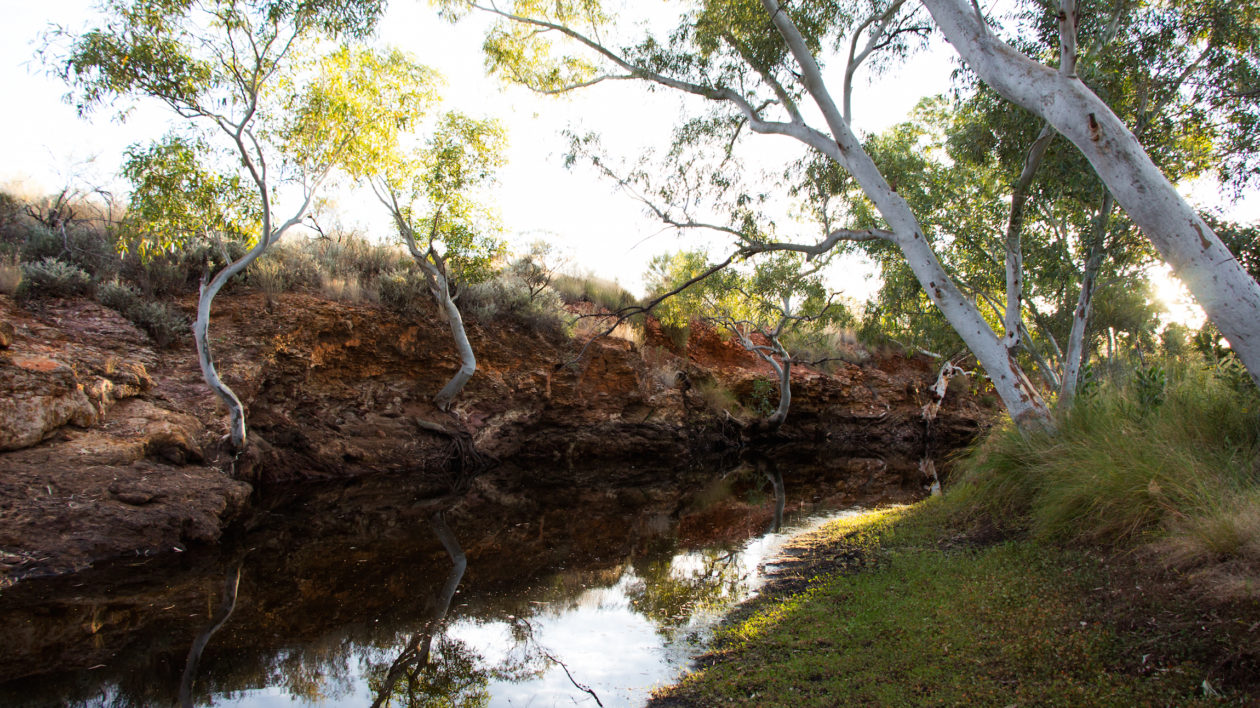
With all of the data loggers deployed, we pack up our Pelican cases and cinderblocks for the multi-hour drive back to Parnngurr community. The acacia blossoms glow yellow in the afternoon sun as the perpetual cloud of zebra finches chatter near the pool’s edge.
Ngamaru looks back at the waterhole one last time, nodding silently to herself before climbing into the Land Cruiser. And then we drive on, our route home marked by a single set of camel footprints in the red sand.
This research was initiated as part of the Martu Living Deserts Project, funded by BHP Billiton, to conserve part of the world’s most intact desert.
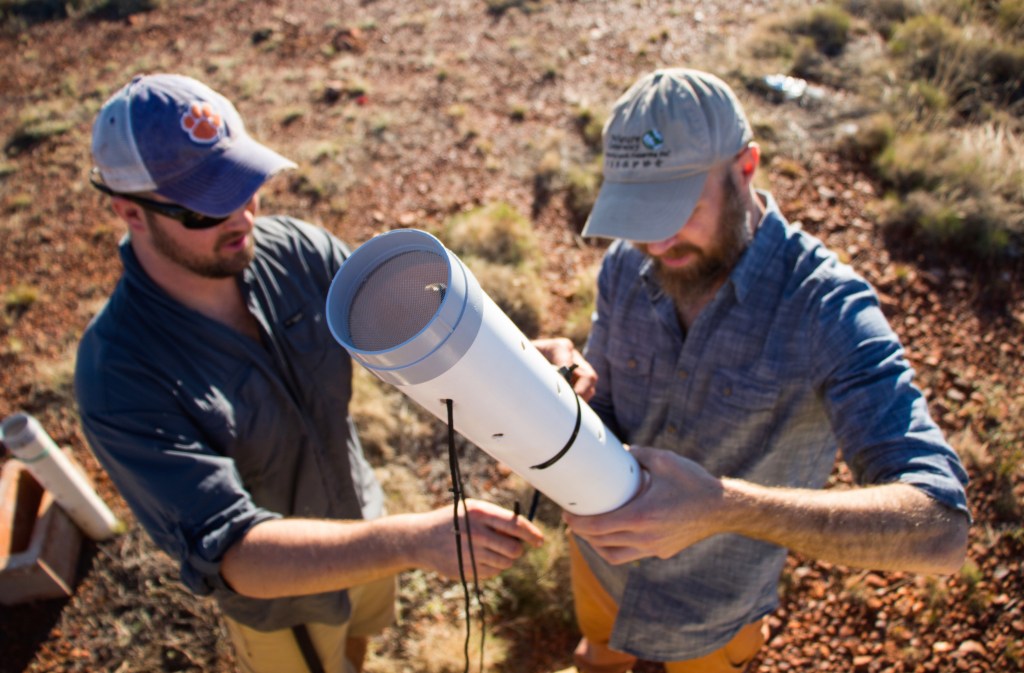



really enjoyed this story. My knowledge of Martu is limited, but am interested in studying impacts of feral communities in any terrestrial environment. Thank you for broadening my base knowledge. Also as a volunteer water quality monitor I am very interested in these DO data recorders you mentioned. Fascinating.
Are we at the point of just documenting climate and ecological/environmental fluctuations or are we at the point of documenting long term world climate changes? We will only know when the documentation and data is assessed over the next 50-100 years.
Are the camels a danger to humans? Will they attack, as shown in the docum-drama “Tracks”.